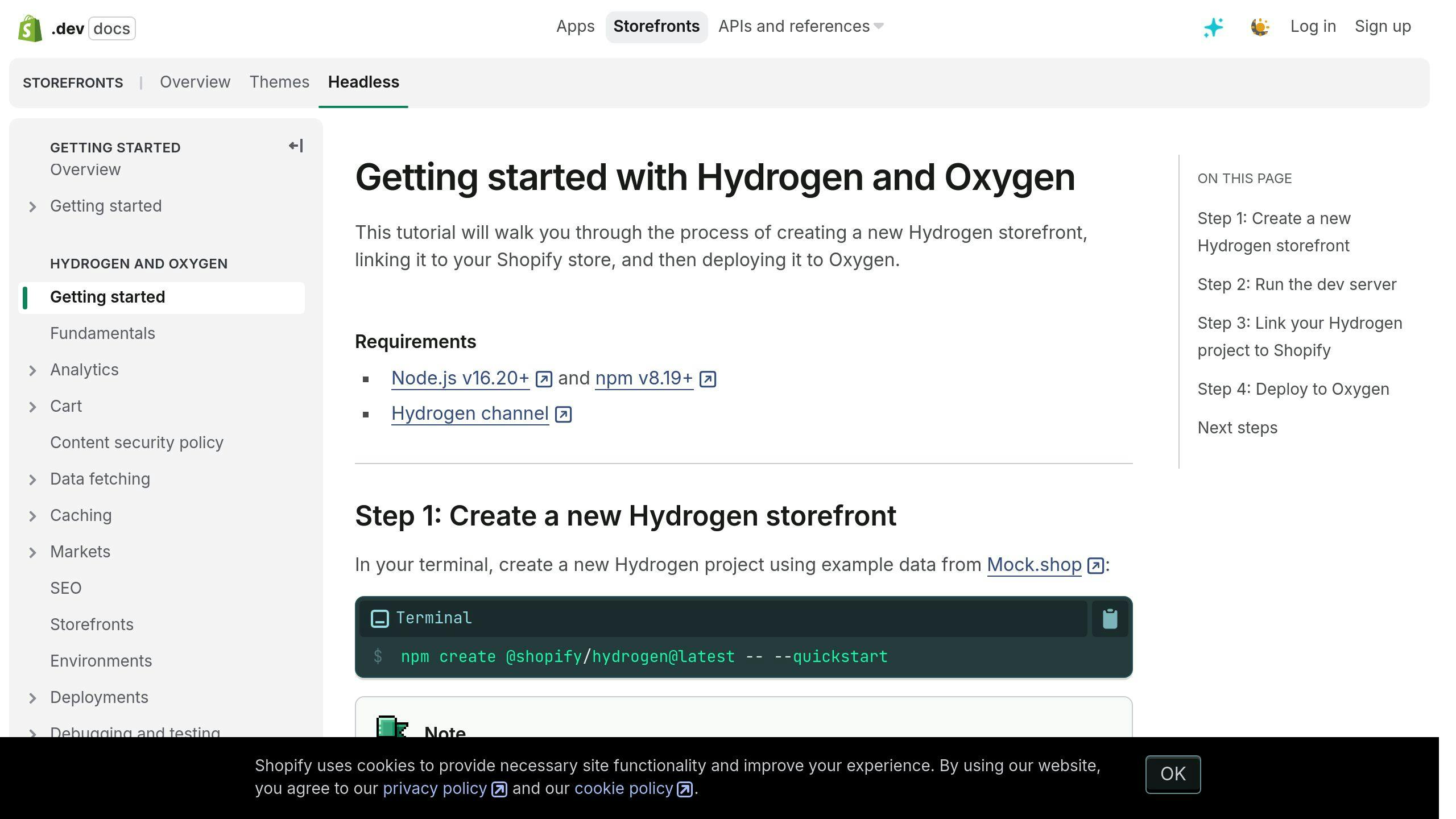By Mladen Terzic
Shopify Headless & Hydrogen
9th Dec 2024
10 min read
Shopify vs Headless Commerce: Which to Choose in 2025
Learn the key differences between Shopify and headless commerce. This guide breaks down setup costs, customization, scalability, and technical requirements, helping you choose the best ecommerce solution for your business goals in 2025.

When deciding between Shopify and headless commerce for your eCommerce business, the choice depends on your goals, technical expertise, and budget. Here's a quick breakdown:
- Shopify: Easy-to-use, all-in-one platform ideal for small to medium businesses. It's quick to set up, affordable, and requires minimal technical knowledge. However, customization options are limited.
- Headless Commerce: Offers high flexibility and scalability by separating the front-end from the back-end. It's perfect for enterprises or growing brands needing advanced customization and multi-channel capabilities. But it demands more technical expertise and comes with higher costs.
Quick Comparison
| Feature | Shopify | Headless Commerce |
|---|---|---|
| Setup Cost | Lower | Higher |
| Customization | Limited to moderate | Extensive |
| Technical Expertise | Basic | Advanced |
| Scalability | Good | Excellent |
| Speed to Launch | Faster | Slower |
| Maintenance | Low | High |
If you need simplicity and affordability, Shopify is a great choice. For businesses prioritizing unique customer experiences and global scale, headless commerce is worth considering.
Strengths and Weaknesses of Each Approach
Pros and Cons of Shopify

Shopify stands out for its easy-to-use, all-in-one platform that includes tools for website design, inventory management, and payment processing. Its straightforward setup and wide app marketplace make it a great choice for small to medium-sized businesses.
On the downside, Shopify's built-in structure can limit businesses looking to create highly personalized or advanced shopping experiences. The close connection between the front-end and back-end can make it harder to implement unique features or custom designs.
Pros and Cons of Headless Commerce
Headless commerce is all about flexibility and scalability. By separating the front-end (what customers see) from the back-end (how the system works), businesses can fully control their customer experience. This makes it ideal for large enterprises or fast-growing brands that want tailored, multi-channel experiences. For example, Sennheiser adopted a headless system and saw noticeable improvements in site performance and conversions.
The trade-off? Headless commerce requires more technical know-how and higher upfront investment. While the payoff can be worth it - better performance and customization - it may not be the best fit for smaller businesses or those with limited tech resources.
Comparison Chart: Shopify vs Headless Commerce
| Feature | Traditional Shopify | Headless Commerce |
|---|---|---|
| Initial Setup Cost | Lower | Higher |
| Development Speed | Faster | Slower |
| Customization Options | Limited to moderate | Extensive |
| Technical Expertise | Basic to intermediate | Advanced |
| Content Update Speed | Standard | Faster |
| Omnichannel Capabilities | Basic | Advanced |
| SEO Control | Moderate | Comprehensive |
| Performance Optimization | Good | Excellent |
| Maintenance Complexity | Low | High |
"Headless architecture provides developers with flexibility and full control over a modular, customizable system."
Both Shopify Plus and headless commerce offer powerful tools, but the right choice depends on your business goals and resources. The following examples will show how companies have used each approach to their advantage.
Examples of How Each Approach Works
Using Shopify Plus for Business Growth

Shopify Plus helps businesses grow by offering powerful automation tools and multi-channel management. Its integrated dashboard allows merchants to handle sales across platforms like social media and online marketplaces while keeping inventory and order processes in sync.
Take Nour Hammour, for example. The luxury brand used Shopify Plus to establish a smooth multi-channel presence. By implementing automated workflows and integrated inventory systems, they achieved impressive results during their Paris Fashion Week launch. The outcome? A 63% increase in year-over-year conversion rates and a 128% jump in sales. Shopify Plus made scaling seamless for their business.
While Shopify Plus is great for businesses looking for scalability and simplicity, Shopify Hydrogen caters to those needing advanced technical customization.
Using Shopify Hydrogen for Headless Commerce

Shopify Hydrogen is designed for creating custom storefronts. It combines Shopify’s robust backend with the flexibility to build unique user experiences. Developers can use modern web technologies to design tailored storefronts while relying on Shopify's APIs for essential features. This makes it a go-to solution for businesses requiring advanced customization and high performance.
Case Studies: Success Stories
Real-world examples highlight the impact of headless commerce. For instance, Ruggable maintained 100% uptime during Black Friday, expanded into eight markets, and improved both site speed and SEO performance.
Sennheiser experienced a 4.5% boost in conversion rates, quicker market expansion, and stronger global engagement after adopting a headless approach.
"The switch to headless empowered us to rapidly open in new markets and improve the customer experience", shared a Sennheiser representative, emphasizing how the architecture supported their global growth strategy.
These stories show how Shopify Plus and Shopify Hydrogen can deliver outstanding results when aligned with a business’s specific goals and technical requirements.
Understanding the Difference Between Shopify and Headless Commerce
sbb-itb-6dc743d
Factors to Consider When Choosing
When deciding between Shopify and headless commerce solutions for 2025, it's important to weigh several factors that could impact your business's success. Here are the key points to keep in mind.
Growth and Scalability
Headless commerce systems are built to handle large-scale growth and complex operations across multiple markets. They perform well during traffic surges, simplify international expansion, and efficiently manage intricate workflows. This makes them a strong option for businesses planning to expand rapidly or operate globally.
On the other hand, Shopify provides a more straightforward approach, which might suit businesses with less complex needs. While scalability is about how your business grows, customization is what sets it apart.
Customization Needs
The level of customization your business requires plays a big role in this decision. Shopify offers a range of built-in features, but headless commerce allows for much greater flexibility, enabling one-of-a-kind customer experiences.
| Customization Level | Recommended Approach | Best For |
|---|---|---|
| Basic to Moderate | Traditional Shopify | Small to medium businesses with standard ecommerce needs |
| Advanced | Shopify Plus | Growing businesses needing extra features |
| Extensive | Headless Commerce | Enterprises wanting full control over user experience |
For instance, a small boutique might find Shopify's pre-designed themes ideal, while a global retailer like Sennheiser may need headless commerce to deliver tailored shopping experiences across different regions.
Technical Skills and Budget
Recent trends show that 67% of companies are planning to adopt or improve headless systems and other modern architectures, highlighting a shift in ecommerce technology.
To make this transition successful, consider:
- Technical Expertise: Headless commerce requires experienced developers skilled in modern web technologies and APIs. Shopify, in contrast, is easier to manage with minimal technical know-how.
- Budget: Headless commerce involves higher upfront costs and ongoing development expenses. Shopify, however, offers predictable pricing and user-friendly tools.
For businesses leaning toward headless commerce, Shopify's Hydrogen and Oxygen platforms offer advanced features with simplified hosting and deployment. These tools are an excellent starting point for companies looking to move toward more advanced ecommerce solutions.
Conclusion: Choosing the Right Option for Your Business
Key Takeaways
Deciding between Shopify and headless commerce in 2025 boils down to your business's specific needs, technical skills, and growth objectives. Shopify's traditional platform works well for small to medium businesses that prioritize simplicity and predictable costs. On the other hand, headless commerce stands out for its flexibility and scalability, making it a better fit for businesses with complex requirements or international ambitions.
Let’s break it down further to help you make an informed choice.
Recommendations to Consider
Shopify's Hydrogen offers a headless commerce solution, enabling businesses to create custom storefronts while using Shopify's backend. For instance, Nour Hammour successfully used headless commerce to deliver a shopping experience that seamlessly integrated content and commerce.
Here’s a practical framework to guide your decision:
| Business Need | Best Choice | Why It Fits |
|---|---|---|
| Rapid Market Entry | Traditional Shopify | Lower setup costs, quick launch, and minimal technical expertise required |
| Advanced Customization & Scale | Headless Commerce | Allows tailored experiences and supports seamless operations across regions |
| Limited Technical Resources | Traditional Shopify | Easy-to-use interface and access to a wide range of apps |
If you're leaning toward headless commerce, Shopify's Hydrogen could be a great option. It offers advanced features without the complexity of building a fully custom solution from scratch.
Ultimately, your decision should reflect your business goals, technical capacity, and budget. If you're aiming for rapid growth or need highly personalized customer experiences, headless commerce might be worth the investment. However, if you're focused on establishing a reliable ecommerce store with standard features, Shopify's traditional platform is a solid, budget-friendly option.
FAQs
Can Shopify be headless?
Yes, Shopify supports headless commerce through three main tools:
- Storefront API: Offers API-based access to Shopify's commerce features.
- Hydrogen: A React-based framework for building custom storefronts.
- Oxygen: A hosting platform optimized for Hydrogen-powered storefronts.
These tools let businesses use Shopify's backend while creating a fully customized front-end. This setup gives you the freedom to design unique shopping experiences while still relying on Shopify's trusted infrastructure.
Whether headless Shopify is the right fit depends on your business needs and available resources.
Is headless Shopify worth it?
Headless commerce separates the front-end design from the back-end operations, offering more flexibility and customization options. Whether it's worth it depends on your specific goals. Here's a quick breakdown:
| Business Need | Headless Advantage | Real Impact |
|---|---|---|
| Multi-channel Presence | Unified backend across platforms | Easier integration across web, mobile, and IoT devices. |
| Performance | Separate scaling for front/back ends | Faster load times and better traffic management. |
That said, headless Shopify comes with higher upfront costs, requires advanced technical expertise, and demands ongoing development. If your business has limited technical resources or simpler ecommerce needs, sticking with traditional Shopify might be a better option. The choice should reflect your growth plans, technical capabilities, and long-term resources.


